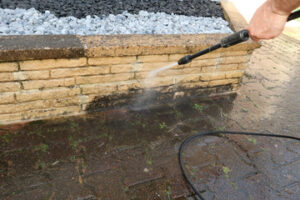Summerville Pressure Washing is the best way to remove deeply ingrained dirt, mildew and other materials from exterior surfaces. It also helps prevent damage to surfaces and lengthens the life of paint jobs.

Be sure to use the proper safety equipment (eye and hearing protection) when using a pressure washer. Understand that the color of nozzles indicate different spray patterns and levels of pressure.
Pressure washing is an effective solution for eliminating mildew. This is especially true for surfaces that are often affected by mildew growth such as roofs, fences, decks, siding, and concrete. Mildew is a problem that can negatively impact the appearance of these surfaces as well as their structural integrity and overall safety. Regularly cleaning these areas with pressure washing can help prevent mildew from developing and re-growing, thus reducing maintenance costs.
Mildew requires a moist environment to develop, and high levels of humidity and organic materials can fuel its growth. Pressure washing effectively removes these elements, as well as the spores that fuel mold growth. Regularly scheduled pressure washing can thus greatly reduce the risk of future mildew infestations, as well as moss and mold growth in general.
Moreover, combining specialized attachments with eco-friendly detergents enhances the efficacy of mildew removal. Many traditional mildew removers contain chemicals that can be harmful to ecosystems, particularly if runoff into waterways. However, advances in cleaning technology and a growing emphasis on sustainability have led to the development of biodegradable mildew removers that achieve similar results without damaging surrounding flora or water supplies.
The right equipment and technique also play a key role in the effectiveness of pressure washing for mildew removal. Using a wide spray pattern and overlapping strokes helps ensure that all affected areas are thoroughly cleaned, preventing missed spots that may lead to re-growth. Lastly, utilizing hot water rather than cold water increases the effectiveness of mildew removal by loosening and dissolving grime more quickly.
In addition, it is important to use proper personal protective equipment (PPE) when pressure washing. This includes safety goggles, gloves, and sturdy footwear to protect against splashes or contact with harsh chemicals. Finally, selecting a pressure washer that is appropriate for the task at hand will help minimize damage and ensure safe operation.
Professionally maintained and used pressure washers are designed to handle a variety of jobs and surface types, including soft and hard surfaces. However, it is always best to consult a professional before renting or purchasing a machine, as they have the experience and training needed to safely and effectively use these tools.
Removes Algae and Mold
Pressure washing is a safe and effective way to remove mold and mildew stains from exterior surfaces. It can effectively eliminate the organic materials that mold and mildew thrive on, including dirt, leaves, pollen, and sap. Regular power washing prevents mold and mildew from growing and causing damage to your home. Matt The Driveway Guy recommends cleaning your roof, driveway, patios, decks, and siding twice a year—once in the spring to remove dirt and grime that has accumulated over the winter and once in late fall to remove mildew and mold that has grown during the summer.
Moss, mold, and mildew can cause serious damage to your home if not removed properly. They may eat through paint, rot wood, erode shingles, and cause health issues for you and your family. Whether it’s green mildew on your roof, or ugly stains on your siding, you should contact a professional to pressure wash your home. They will know the right psi and water flow to use for different types of surfaces and will also be able to safely use cleaning solutions that will remove all traces of algae, mold, and mildew.
The combination of hot water and biodegradable cleaners makes pressure washing especially effective for removing stubborn stains. The biodegradable cleaners loosen dirt, grease, oil, and other debris and help them break down and be rinsed away. They also help to prevent the buildup of such substances on the surface afterward, preventing them from returning.
Unlike traditional at-home pressure washers, professional pressure washing equipment can reach much higher levels of psi and waterflow. This means that they are more effective at removing dirt, mud, and other unwanted substances from hard-to-reach places. Additionally, a professional knows how to safely and effectively use these tools on various types of surfaces, such as concrete, brick, stone, and wooden surfaces.
Prevents Damage
When dirt, mildew, mold, algae and other contaminants build up on exterior surfaces they can cause a variety of problems. These include slippery spots that create hazards for guests and customers, moisture absorption that causes rotting or corrosion over time, and structural weakness as the materials degrade. Regularly pressure washing these surfaces protects and extends their lifespan, preventing these issues and saving money on expensive repairs down the road.
Professionals use industrial-grade equipment and are familiar with how different cleaning products affect various surface types. In contrast, a homeowner may accidentally damage surfaces with too much water or inappropriate cleaning chemicals. This could strip paint off walls, etch concrete or splinter wood.
Pressure washing removes these contaminants and helps prepare the surface for a fresh coat of paint. It also allows the paint to adhere properly, ensuring it looks great and lasts longer. Pressure washing is also useful in preparation for refinishing projects, such as staining or re-coating. It removes old finish and loosens adhesion to help ensure a smooth, even coat that won’t crack or peel over time.
Including pressure washing as part of your annual exterior maintenance routine prevents costly damages to your home or business. In addition, it keeps your property looking its best and makes a good impression on guests, customers or potential buyers.
Surfaces like patios, sidewalks, driveways and rooftops are constantly exposed to dirt, debris, pollen, pollutants, and other contaminants. If these are left unattended, they can eat away at surfaces and cause structural damage, leaving them with an unsightly appearance or weakening their durability over time. Pressure washing regularly eliminates these harmful substances and protects building materials to preserve their beauty, strength and functionality.
In 2025, it’s important to assess each material type and its tolerance level to pressure washing to avoid unnecessary damage. Proper machine settings and nozzle selection will enable cleaning while protecting surface integrity. It’s a good idea to test the pressure on an inconspicuous area of each surface to see how it reacts and to find the ideal setting without damaging it.
Saves Money
Many property owners overlook the importance of regular pressure washing, which can prevent future damage and save money. Aside from boosting curb appeal, which can help you sell your home quickly and for more money, it removes harmful contaminants that would otherwise shorten the lifespan of surfaces like siding, roofs, driveways, walkways, decks, and patios.
Dirt, mold, mildew, algae and other substances can eat away at the surface of your home’s exterior paint and cause rot and decay. Those issues may seem minor and insignificant, but they can lead to costly repainting and repairs later on. Keeping your home clean with regular pressure washing and soft washing eliminates these problems early on.
Similarly, gutters clogged with debris reduce airflow and force your HVAC system to work harder. Dirt and grime buildup on windows, doors, and trim can also lower efficiency. Pressure washing removes these items and helps your home run more smoothly, saving you money on energy bills in the long run.
Even vinyl siding is vulnerable to deterioration over time, especially in the sun, due to UV radiation. Getting rid of stains, mold, and mildew with a regular cleaning will keep your vinyl looking newer longer, reducing the cost of replacement.
Aside from preventing damage and improving the longevity of your home’s surfaces, regular cleanings with pressure washing or soft washing are an effective way to protect your family’s health. The removal of slippery substances like algae and moss reduces the risk of falls, while removing allergens like pollen and dust minimizes respiratory issues.
While some people choose to purchase a pressure washer and try to clean their own homes, the use of this tool requires training, safety equipment, and knowledge of the proper settings and techniques for each surface type. Professionals are experienced in using pressure washing tools and can assess the situation to determine if high-pressure water or soft washing is appropriate for each surface, ensuring they are not being damaged by the high pressure. They can also test the pressure on an inconspicuous area before applying it to your home, avoiding damage from too much or too little water flow.




